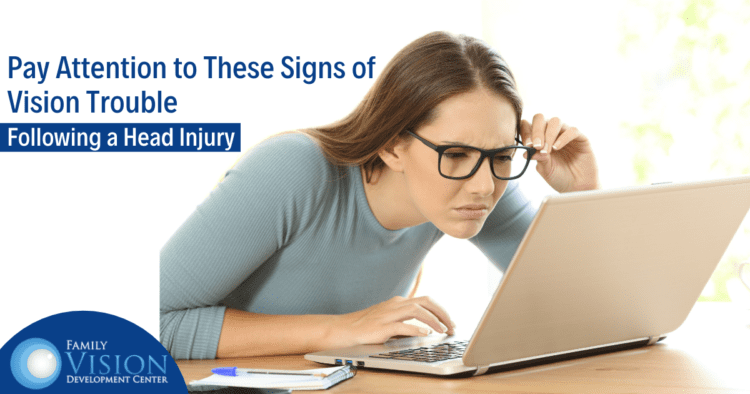A blow or jolt to the head is a serious thing and should never be taken lightly, as it can result in a traumatic brain injury (TBI). Whether it is mild (often referred to as a concussion) or severe, a TBI can have lasting effects, especially when it comes to your vision. There are many events or circumstances that can cause a concussion or traumatic brain injury, such as:
- Falling
- Stroke
- Blunt force trauma
- Car accident
- Physical assault
- Sports activity collision
If you have experienced any of these, you should be on the lookout for some common visual symptoms that often follow a concussion or TBI.
Vision Issues Often Associated with a Brain Injury
A majority of people who experience a TBI or concussion-related injury will suffer from one or more of the following visual impairments:
- Blurry vision
- Double vision
- Problems with eye movements or tracking
- Depth perception issues
- Peripheral vision loss
- Light sensitivity
- Reading difficulties
- Aching eyes
- Eye teaming issues
- Improper eye alignment/eye turn
Unfortunately, many instances of injury-related vision problems go undiagnosed in the beginning. The symptoms may seem mild or insignificant at first, and therefore medical treatment is not deemed necessary. However, if left untreated, these issues can become much more serious.
Vision Therapy Following a Brain Injury
If you experience any kind of injury to the head, it is important to see both your medical doctor and an eye doctor who has specific training in TBI and concussion-related vision problems. At Family Vision Development Center, our professional team has advanced training in neuro-optometric vision rehabilitation, which means we understand these types of injuries as well as the treatment needed to restore proper vision. Using customized, therapeutic eye exercises, our specialized vision therapy programs are an extremely effective way to retrain the eyes and brain in order to recover normal visual skills.
We understand that each patient is unique and each vision therapy treatment plan should fit their specific needs. As such, we provide each of our patients with a comprehensive neuro-optometric vision evaluation in order to create an individualized treatment program using the most current and effective vision therapy methods available. We look forward to getting your vision back to normal so you can get back to enjoying life! Give us a call at 630-862-2020 to schedule your appointment.
Do you ever go outside on a sunny day and the bright light actually causes pain in your eyes? Or maybe you walk into a brightly-lit room and immediately feel the need to squint? This negative reaction to light is known as photophobia, or light sensitivity. Photophobia is not an eye disease, but rather a symptom of a number of possible conditions.
Possible Reasons for Light Sensitivity
There are a number of possibilities when it comes to determining why your eyes are sensitive to light. Some proven causes include:
Migraine headaches
Migraines are severe headaches that can be triggered by a number of factors, such as hormonal changes, stress or the environment. Light sensitivity is a very common symptom of migraines and many people feel the need to dim the lights during a migraine attack in order to help ease the pain.
Conditions That Affect the Brain
Photophobia can be associated with certain serious brain conditions. Symptoms of these conditions can include inflammation in or surrounding the brain, or bleeding near the brain. These conditions can be life-threatening and immediate care should be sought if they are suspected.
- Encephalitis
- Meningitis
- Subarachnoid hemmorrhage
- Mild traumatic brain injuries (mTBI) or concussions
Conditions That Affect the Eyes
Light sensitivity can also be caused by a number of eye conditions including:
- Dry eye syndrome – tears do not provide adequate moisture
- Conjunctivitis – also known as “pink eye”
- Cataracts – cloudy coverings over the lenses of the eyes
- Corneal abrasion – a scratch or injury to the cornea
- Scleritis – inflammation of the white part of the eye
Medications
Certain medications have been known to cause excess light sensitivity for some people, including:
- Some antibiotics
- Tricyclic antidepressants
- Certain acne medications
- Medications used to treat malaria
- Some heart medications
- Certain diabetes drugs
What to Do for Photophobia
As previously stated, light sensitivity is a result of an underlying condition. Therefore, treatment is most often accomplished by addressing that specific condition. Once the underlying condition is treated, the light sensitivity should resolve on its own. Additionally, you can try the following suggestions:
- Wear quality sunglasses with polarized lenses when outdoors
- Ask your doctor if light sensitivity is a side effect of any medications you are currently taking
- Try to increase natural lighting at the office by turning off the fluorescent bulbs and opening window blinds
- Get regular vision and medical exams to detect any abnormalities as early as possible
At Family Vision Development Center, we can help determine the underlying cause of your photophobia and work with you to discover the best treatment options. Regular comprehensive vision exams are the best way to monitor your eye health, as we can quickly notice any changes in vision and start treatments as early as possible. Contact our Aurora office at 630-862-2020 to learn more or to schedule an appointment.



